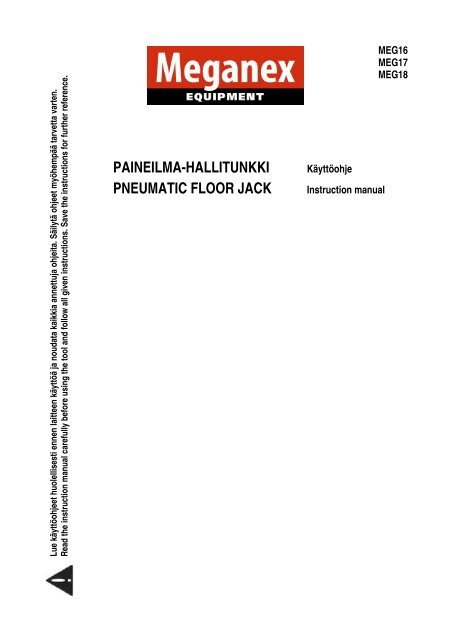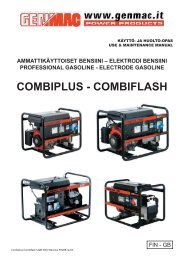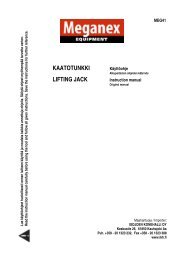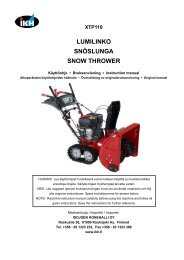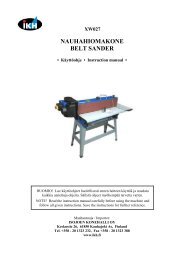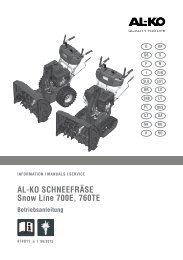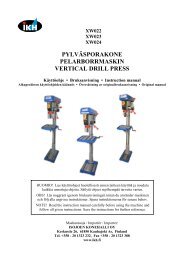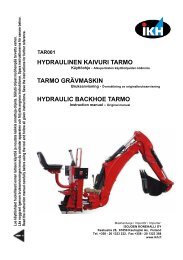Liitetiedosto (pdf) - Virtasenkauppa.fi
Liitetiedosto (pdf) - Virtasenkauppa.fi
Liitetiedosto (pdf) - Virtasenkauppa.fi
- No tags were found...
Create successful ePaper yourself
Turn your PDF publications into a flip-book with our unique Google optimized e-Paper software.
2. Ilmalähteen valinta: Tunkin kanssa käytettävä kompressoria, jonka tuotto on vähintään 400 l/min. Kompressorinulostuloletkun halkaisijan on oltava vähintään 8 mm ja ilmanpaineen on oltava välillä 6-10 bar.Paineilman on oltava puhdasta ja kuivaa (öljyn-vedenerottimen käyttö on suositeltavaa).Öljyn-vedenerotinIlmansuodatinKompressoriPainemittariTyhjennysventtiili3. Kytke ilmaletku. (Katso kuva C)4. Esineen paino on arvioitava ennen nostoa. Tunkkia ei saa koskaan ylikuormittaa.5. Määrittele esineen painopiste ja tunkin työskentelypiste. Aseta tunkki tukevasti lattialle. Huomioi lattianriittävä lujuus ja kantavuus.6. Käännä säätöventtiilin kahvaa myötäpäivään nostaaksesi esineen. Kun laite saavuttaa määräkorkeutensa,pysähtyy se automaattisesti. VAROITUS! Älä koskaan nosta käynnissä olevaa ajoneuvoa tai käynnistänostettuna olevaa ajoneuvoa.7. Työskentely nostetun ajoneuvon läheisyydessä on vaarallista. Älä liikuta tunkkia sen kannattaessa ajoneuvoa.Vältä nostetun ajoneuvon alla työskentelemistä sekä minkään kehon osan viemistä ajoneuvon alle.Pidä mielessäsi vääntövoima esim. pultteja tai muttereita irrottaessasi, sillä äkillinen liike saattaa aiheuttaaajoneuvon putoamisen autopukeilta ellei sitä ole huolellisesti tuettu. Älä yritä käynnistää nostettuaajoneuvoa.8. Laske tunkki kääntämällä säätöventtiilin kahvaa vastapäivään. Pneumaattisen rakenteen ansiosta tunkkilaskee automaattisesti. VAROITUS! Varmista ennen ajoneuvon laskemista ettei sen alla tai lähistöllä oleihmisiä tai esineitä.9. Mikäli useita tunkkeja käytetään samanaikaisesti, on kaikkien tunkkien nostonopeus pidettävä yhtä suurenaja jokaisen tunkin kannattaman kuorman on oltava samansuuruinen kuorman putoamisen estämiseksi.10. Älä ravistele tai tärisytä laitetta äkillisesti käytön aikana.11. Käsittele ilmaletkuja varovasti: niitä ei saa taivuttaa väkisin, raahata tai hiertää maassa eikä niiden yli saakuljettaa mitään esineitä.HUOLTOLaite suositellaan huollettavan kuukausittain. Tunkkien voitelu on äärimmäisen tärkeää, sillä ne kannattavatraskaita kuormia. Mikä tahansa liasta, ruosteesta tai muusta vastaavasta tekijästä aiheutuva rajoite voi aiheuttaajoko liikkeiden hidastumista tai erittäin nopeita nytkähdyksiä, mikä vaurioittaa laitteen sisäkomponentteja.Seuraavat ohjeet on laadittu tunkin ylläpitämiseksi huollettuna ja toimintakuntoisena.- Voitele sylinteri, liitoskohdat, satula ja pumppumekanismi kevyellä koneöljyllä. Voitele myös pyörän laakeritja akselit.- Tarkista tunkki silmämääräisesti halkeilleiden hitsisaumojen, vaurioiden, taipuneiden, löysällä olevien taipuuttuvien osien sekä hydrauliöljyvuotojen varalta.5
- Mikäli tunkki on altistunut epätavalliselle kuormitukselle tai iskulle, tai mikäli siinä havaitaan vaurioita, kulumiatms., on se välittömästi poistettava käytöstä ja korjautettava valtuutetussa huoltoliikkeessä. Korjaussaattaa vaatia erityisvälineitä sekä erikoisasiantuntemusta, joten sen saa suorittaa ainoastaan valtuutettuhuoltoliike alkuperäisvaraosia käyttäen.- Pidä laite puhtaana ja estä epäpuhtauksien kuten hiekan, soran ja lian pääsy järjestelmään.- Puhdista kaikki pinnat ja pidä kaikki tarrat ja varoitukset hyvässä kunnossa ja lukukelpoisina.- Tarkista ja ylläpidä sylinterin öljytaso. Käytä aina uutta ja puhdasta hydraulilaitteille sopivaa hydrauliöljyä,älä koskaan käytä jarrunestettä, vaihteistoöljyä, alkoholia tai tavallista moottoriöljyä.- Tarkista sylinteri kolmen kuukauden välein ruosteen ja korroosion varalta. Puhdista tarvittaessa ja pyyhiöljytyllä kankaalla.- Kun tunkki ei ole käytössä, jätä aina satula ja sylinteri aivan alhaisimpaan asentoon.- Säilytä tunkkia aina aivan alhaisimmassa asennossa. Tämä suojaa kriittisiä alueita liialliselta ruostumiselta.- Säilytä tunkkia sellaisessa kuivassa ja puhtaassa paikassa, jossa se ei pääse altistumaan syövyttävillehöyryille, kuluttavalle pölylle tai muille vahingollisille tekijöille.- Parhaan suorituskyvyn varmistamiseksi on tunkki suositeltavaa tarkistuttaa vuosittain valtuutetussa huoltoliikkeessä.VIANETSINTÄOngelma Syy Ratkaisu- Kytkin ja rajapinta ovat kuluneet, ilmaletkutovat puhjenneet tai ilmantuloputketvaurioituneet, mistä seuraavuoto ja riittämätön ilman saanti.Pneumaattinen pumppuei toimi tai toimiiriittämättömällä tunkkausvoimalla.Tunkki ei laske.Tunkista vuotaa öljyä.Mäntä ei nouse.- Pneumaattisen pumpun mäntä paisuuja on likainen. Sylinteri ruostuu; riittämättömästiöljyä säiliössä.- Epäpuhtauksia tarkistusventtiilissä taiventtiili on vaurioitunut. Paluuöljyn teräskuulaon vaurioitunut.- Vaurioitunut paluuöljyn putki aiheuttaavuodon eikä pysty pidättämään paluuöljynteräskuulaa.- Mäntä lukittuu eikä pysty pidättämäänpaluuöljyn teräskuulaa. Tiivisterengason vaurioitunut.- Yläpumpun öljytiiviste ja tiivisterengasovat vaurioituneet.- Tarkistusventtiilin sisällä sijaitsevanöljypumpun kovera rengas on vaurioitunut.- Epäpuhtauksia tarkistusventtiilissä taiventtiili on vaurioitunut. Öljyn syötönteräskuula on vaurioitunut.- Vaurioitunut öljynsyöttöputki aiheuttaavuodon eikä pysty pidättämään öljynsyötön teräskuulaa.- Tarkista kytkin, ilmaletkut ja liitoskohdat.Vaihda mikäli ne ovat vaurioituneet.- Puhdista ja vaihda uusi sopiva mäntä.Hio sylinteriä hiomapaperilla; täytäsäiliö öljyllä.- Puhdista tarkistusventtiili ja vaihdateräskuula. Vaihda tarkistusventtiilimikäli se on vaurioitunut.- Vaihda paluuöljyn putki.- Vaihda mäntä ja tiivisterengas.- Vaihda öljytiiviste ja tiivisterengas.- Vaihda kovera rengas.- Puhdista tarkistusventtiili ja vaihdateräskuula. Vaihda tarkistusventtiilimikäli se on vaurioitunut.- Vaihda öljynsyöttöputki.- Pneumaattinen pumppu ei toimi. - Tarkista pneumaattinen pumppu.- Säiliössä ei ole öljyä. - Täytä säiliö öljyllä.6
IMPORTANTGBREAD THESE INSTRUCTIONS CAREFULLY AND NOTE THE SAFETY INSTRUCTIONS AND WARNINGS.USE THE PRODUCT CORRECTLY AND WITH CARE FOR THE PURPOSE FOR WHICH IT IS INTENDED.FAILURE TO DO SO MAY CAUSE DAMAGE TO PROPERTY AND/OR SERIOUS PERSONAL INJURY.KEEP THIS INSTRUCTION MANUAL SAFE FOR FUTURE USE.INTRODUCTION- This product is a new type of pneumatic hydraulic hoisting equipment with telescopic ram units. It is safe,easy to use, low, lightweight and easy to move, and it has large lifting capacity and wide application range.SPECIFICATIONSMEG16Max. capacityWorking pressureMin. heightLifting heightExtension piecesRated pressureNet weight40/20 tons8-12 bar210 mm40 tn: 108,2 mm20 tn: 97,2 mm75 mm + 45 mm320 bar68 kgMEG17Max. capacityWorking pressureMin. heightLifting heightExtension piecesRated pressureNet weight50/25/10 tons8-12 bar160 mm50 tn: 62 mm25 tn: 60,7 mm10 tn: 66,5 mm75 mm + 45 mm320 bar61 kg7
3. When lifting objects, the top plane of the saddle must fully contact with the object to be lifted. Do not liftobjects from a single corner only or with the load straying from some side.PROCEDURES BEFORE LIFTWARNING! Always perform the following procedures before each lift.- Thoroughly inspect the jack for damages or wear and test the jack operation without any load. If the jack isdamaged or is malfunctioning, do not use it until the problem is corrected.- Consult the vehicle owner’s manual for safety precautions, jacking procedure, vehicle weight, recommendedjack type, location of the jack support areas on the vehicle and other necessary information.Never exceed jack’s lifting capacity.- Keep children and other bystanders away from the work area during lifting. However, another adult shouldbe nearby for extra safety and assistance for possible emergency situations.- Clear all needless objects from the work area. Working in cramped or cluttered areas is dangerous.- Make sure the jack and vehicle are on a solid, level ground such as a paved driveway or garage floor.Uneven or sloped surfaces create hazardous working conditions.- Set the vehicle’s hand brake on and shift the gear to lowest driving gear. Turn off the vehicle engine.- Block the vehicle by positioning a wedge tightly on the front and backside of each wheel that is not beinglifted off the ground.- Ensure that there are no persons inside the vehicle to be lifted.- Immediately after the lift, the vehicle must be supported with extra stands, for example with jack stands.Have the extra stands nearby before lifting the vehicle.OPERATIONWARNING! Ensure that you read, understand and apply all instructions. The owner and/or operator isresponsible for providing maintenance and maintaining the jack in good working order. The jack mustbe inspected according to instructions before each use.1. Installation: Install the control lever on the machine with the bolt. Insert the air hose <strong>fi</strong>ttings into the sleevesin accordance with their different external diameters. Pull and lock the control lever so as to lock it in horizontaldirection, 45° and 90° from the machine. (See <strong>fi</strong>gures A and B)A B C9
2. Selection of air supply: Compressor with an output of at least 400 l/min should be used with the jack. Theoutlet hose diameter of the compressor must be at least 8 mm and the air pressure must be within 6-10bar. Use only clean and dry compressed air (the use of an oil-water separator is recommended).Oil-waterseparatorAir<strong>fi</strong>lterAir compressorPressuregaugeDrainingvalve3. Connect the air hose. (See <strong>fi</strong>gure C)4. The weight of the object must be estimated before lifting. Never overload the jack.5. Determine the center of gravity of the object and working point of the jack. Place the jack <strong>fi</strong>rmly on theground. Take solidity and bearing capacity of the ground into consideration.6. Turn the handle of the distributing valve in a clockwise direction to lift the object. When the jack reachesthe rated altitude, it stops automatically. WARNING! Never lift a vehicle with its engine running or start alifted vehicle.7. Working near a lifted vehicle is dangerous. Do not move the jack while it is supporting a vehicle. Avoidworking under a lifted vehicle or placing any part of your body beneath it. Keep in mind torque forces whenloosening bolts or nuts for example, as a sudden move could cause the vehicle to drop from the jackstands if it is not properly supported. Do not try to start a lifted vehicle.8. To lower the jack, turn the handle of the distributing valve in an anticlockwise direction. The pneumaticstructure helps the jack to lower automatically. WARNING! Before lowering the vehicle, make sure thearea under and near the vehicle is clear of all persons and objects.9. If several jacks are used simultaneously, the lifting speed of all jacks must be kept in the same pace andthe load of every jack must be equal to avoid the load from falling.10. Do not shake the jack abruptly when in use.11. Handle air hoses with care: they must not be bent forcibly, dragged or abraded on the ground or rolledover by any objects.MAINTENANCEMonthly maintenance is recommended. Lubrication is critical to jacks as they support heavy loads. Any restrictiondue to dirt, rust etc. can cause either slow movement or extremely rapid jerks, damaging the internal components.The following instructions are designed to keep the jack maintained and operational.- Lubricate the ram, linkages, saddle and pump mechanism with light machine oil. Grease wheel bearingsand axles.- Visually inspect for cracked welds, damages, bent, loose or missing parts and hydraulic oil leaks.- If the jack is subjected to abnormal load or shock, or is found damaged or worn in any way, it must beimmediately removed from service until repaired by an authorized service center. Repair may require spe-10
cialized equipment and knowledge, so it must only be carried out by an authorized service center, usingoriginal spare parts only.- Keep the jack clean and prevent foreign matter such as sand, grit and dirt from entering the system.- Clean all surfaces and maintain all labels and warnings in good condition and legible.- Check and maintain the ram oil level. Always <strong>fi</strong>ll with new, clean hydraulic jack oil, never use brake ortransmission fluids, alcohol or regular motor oil.- Check the ram every three months for any signs of rust or corrosion. Clean as needed and wipe with anoiled cloth.- When not in use, always leave the saddle and ram all the way down.- Always store the jack in fully lowered position. This will protect critical areas from excessive corrosion.- Store the jack in a clean and dry place where it will not be exposed to corrosive vapours, abrasive dust orany other harmful elements.- Annual inspection of the jack is recommended in an authorized service center to ensure the jack is in optimumcondition.TROUBLESHOOTINGProblem Cause Solution- Switch and interface are worn, airhoses are burst or air inlet pipes aredamaged which results in leakageand insuf<strong>fi</strong>cient air supply.Pneumatic pumpdoesn’t work or workswith insuf<strong>fi</strong>cient jackingforce.Jack doesn’t lower.Jack leaks oil.Piston doesn’t lift.- Piston of pneumatic pump expandsand is dirty. Cylinder rusts; insuf<strong>fi</strong>cientlyoil in the tank.- Foreign matter in check valve or valveis damaged. Return oil steel ball isdamaged.- Damaged return oil pipe causes leakageand fails to withhold the return oilsteel ball.- Piston locks and fails to withhold thereturn oil steel ball. Seal ring is damaged.- Oil seal and seal ring in the top pumpare damaged.- Concave ring of the oil pump insidethe check valve is damaged.- Foreign matter in check valve or valveis damaged. Oil feeding steel ball isdamaged.- Damaged oil feeding pipe causesleakage and fails to withhold the oilfeeding steel ball.- Check the switch, air hoses andjoints. Replace if damaged.- Clean and replace it with a suitablepiston. Abrade the cylinder with sandpaper; <strong>fi</strong>ll the tank with oil.- Clean the check valve and replacethe steel ball. Replace the checkvalve if damaged.- Replace the return oil pipe.- Replace the piston and seal ring.- Replace the oil seal and seal ring.- Replace the concave ring.- Clean the check valve and replacethe steel ball. Replace the checkvalve if damaged.- Replace the oil feeding pipe.- Pneumatic pump doesn’t work. - Check the pneumatic pump.- Tank has no oil. - Fill the tank with oil.11
EC DECLARATION OF CONFORMITYWE, CHANGSHU TONGRUN AUTO ACCESSORY CO. LTD.ADDRESS: NEW LONG TENG INDUSTRY AREA, CHANGSHU ECONOMIC DEVELOPMENTZONE, CHANGSHU, JIANGSU, CHINADECLARE, IN SOLE RESPONSIBILITY, THAT THE FOLLOWING MACHINE:PNEUMATIC FLOOR JACKModel No. TRA40-2A, TRA50-3A, TRA40-2AHREFERRED TO IN THIS DECLARATION CONFORMS WITH THE FOLLOWING DIRECTIVE:MACHINERY DIRECTIVE 2006/42/EC.WE WILL KEEP ON FILE FOR REVIEW THE FOLLOWING TECHNICAL DOCUMENTATION:• OPERATING AND MAINTENANCE INSTRUCTIONS• TECHNICAL DRAWINGS• HAZARDS ANALYSIS AND SOLUTIONS• OTHER TECHNICAL DOCUMENTATION SUCH AS QUALITY MEASURES ASSURANCEFOR DESIGN AND PRODUCTIONNOTE: THIS DECLARATION BECOMES INVALID IF TECHNICAL OR OPERATIONMODIFICATIONS ARE INTRODUCED WITHOUT THE MANUFACTURER’S CONSENT.(PLACE AND DATE ISSUED)Dec 15 th , 2009New Long Teng Industry Area,Changshu Economic Development Zone,Changshu, Jiangsu, China(NAME, SIGNATURE AND POSITION)The President of Tongrun Group12
KÄÄNNÖS ALKUPERÄISESTÄEY VAATIMUSTENMUKAISUUSVAKUUTUSME, CHANGSHU TONGRUN AUTO ACCESSORY CO. LTD.OSOITE: NEW LONG TENG INDUSTRY AREA, CHANGSHU ECONOMIC DEVELOPMENT ZONE,CHANGSHU, JIANGSU, CHINAVAKUUTAMME OMALLA VASTUULLAMME, ETTÄ SEURAAVA LAITE:PAINEILMA-HALLITUNKKIMalli Nro. TRA40-2A (IKH-Nro. MEG16), TRA50-3A (IKH-Nro. MEG17),TRA40-2AH (IKH-Nro. MEG18)JOHON TÄSSÄ VAKUUTUKSESSA VIITATAAN, ON SEURAAVAN DIREKTIIVIN VAATIMUSTENMUKAINEN: KONEDIREKTIIVI 2006/42/EY.ME SÄILYTÄMME ARKISTOISSAMME TARKASTUSTA VARTEN SEURAAVAT TEKNISETASIAKIRJAT:• KÄYTTÖ- JA HUOLTO-OHJEET• TEKNISET PIIRUSTUKSET• RISKIANALYYSI JA RATKAISUT• MUUT TEKNISET ASIAKIRJAT KUTEN SUUNNITTELUN JA TUOTANNONLAADUNVARMISTUSTOIMENPITEETHUOMIO: TÄMÄ VAKUUTUS MITÄTÖITYY, MIKÄLI LAITTEESEEN TEHDÄÄN TEKNISIÄ TAITOIMINNALLISIA MUUTOKSIA ILMAN VALMISTAJAN LUPAA.(PAIKKA JA PÄIVÄMÄÄRÄ)Joulukuun 15., 2009New Long Teng Industry Area,Changshu Economic Development Zone,Changshu, Jiangsu, China(NIMI, ALLEKIRJOITUS JA ASEMA)Toimitusjohtaja, Tongrun Group13


